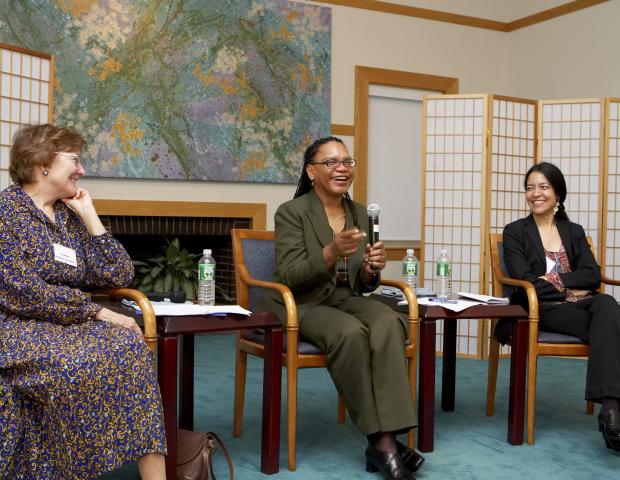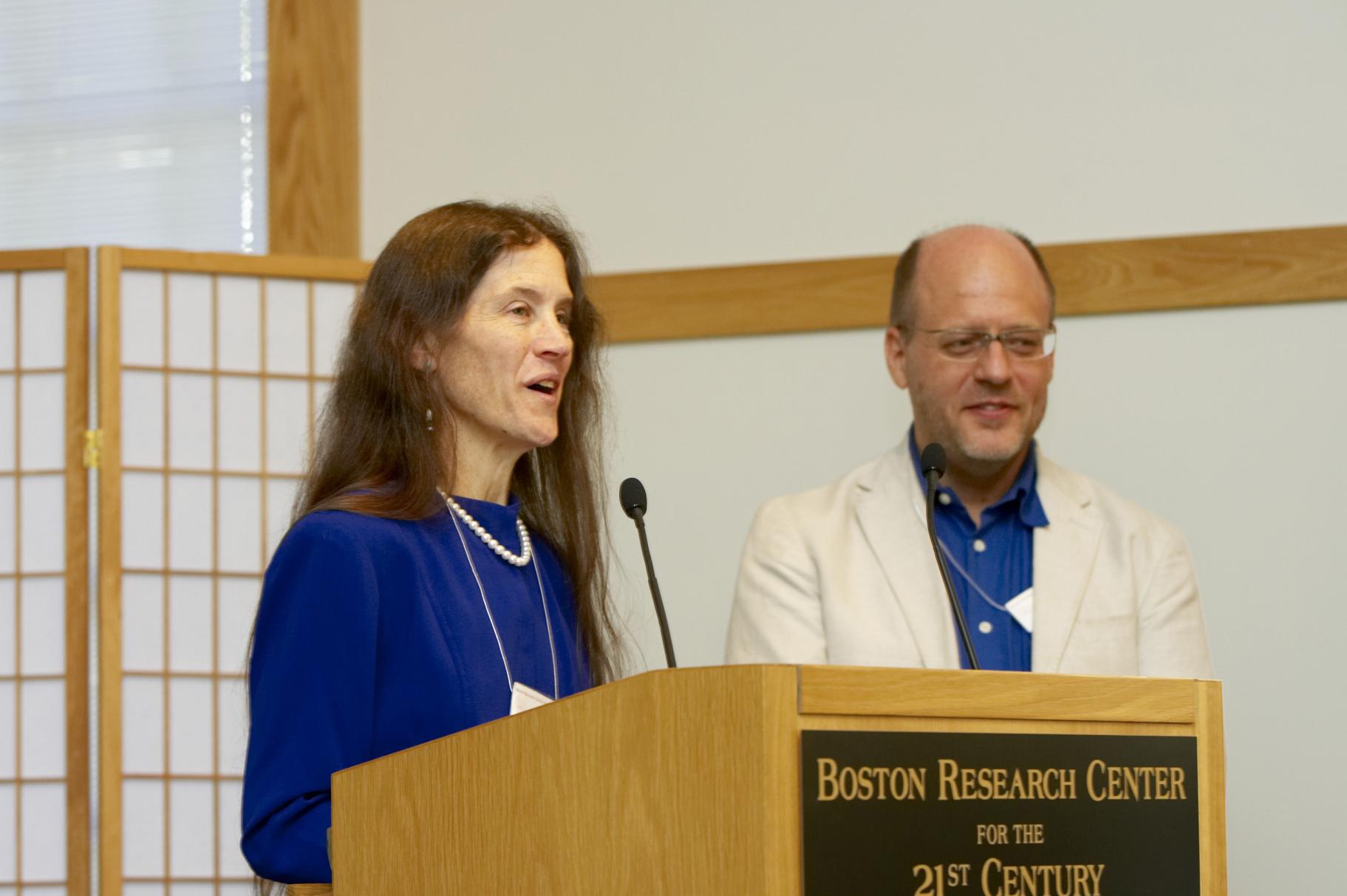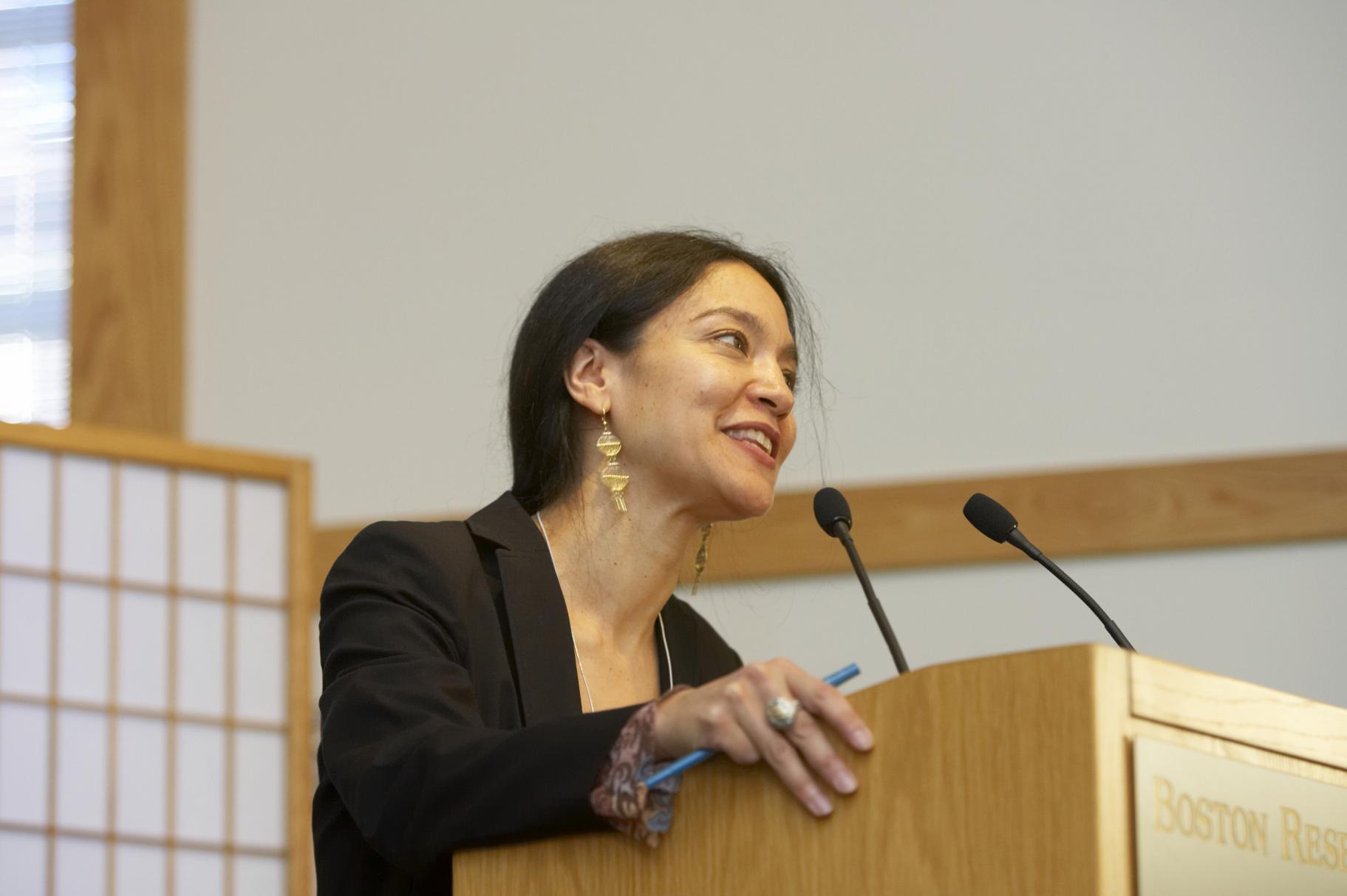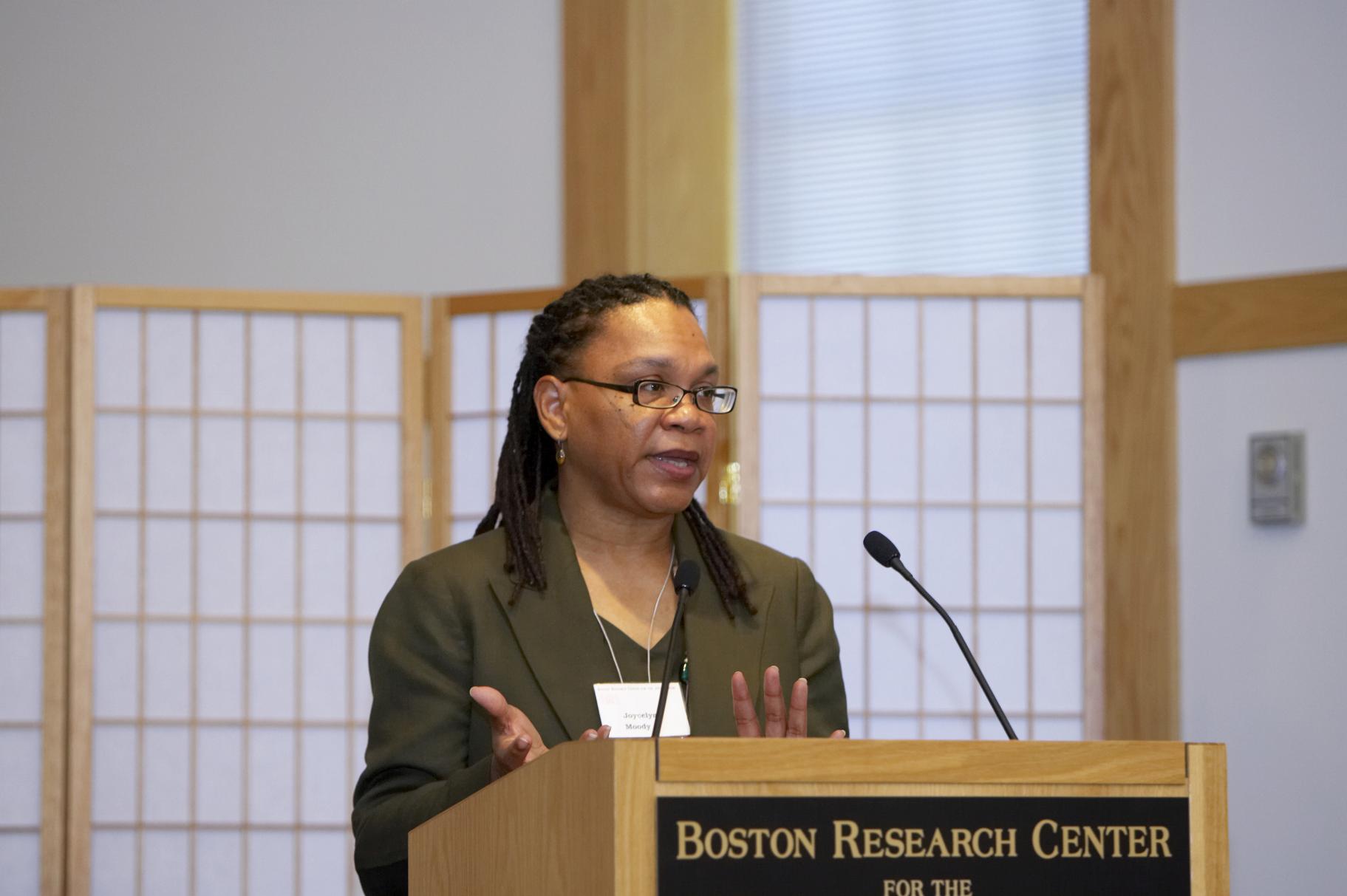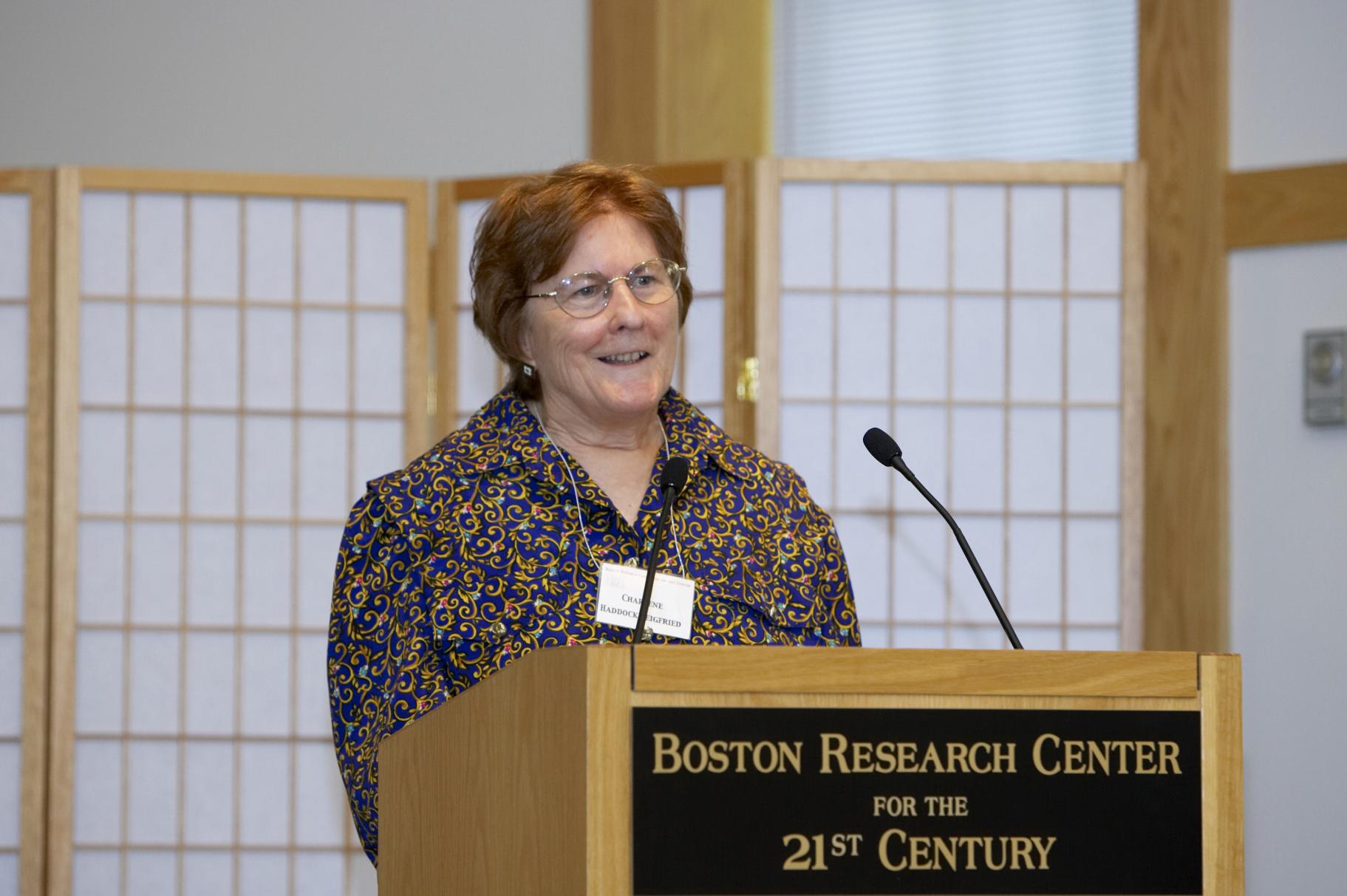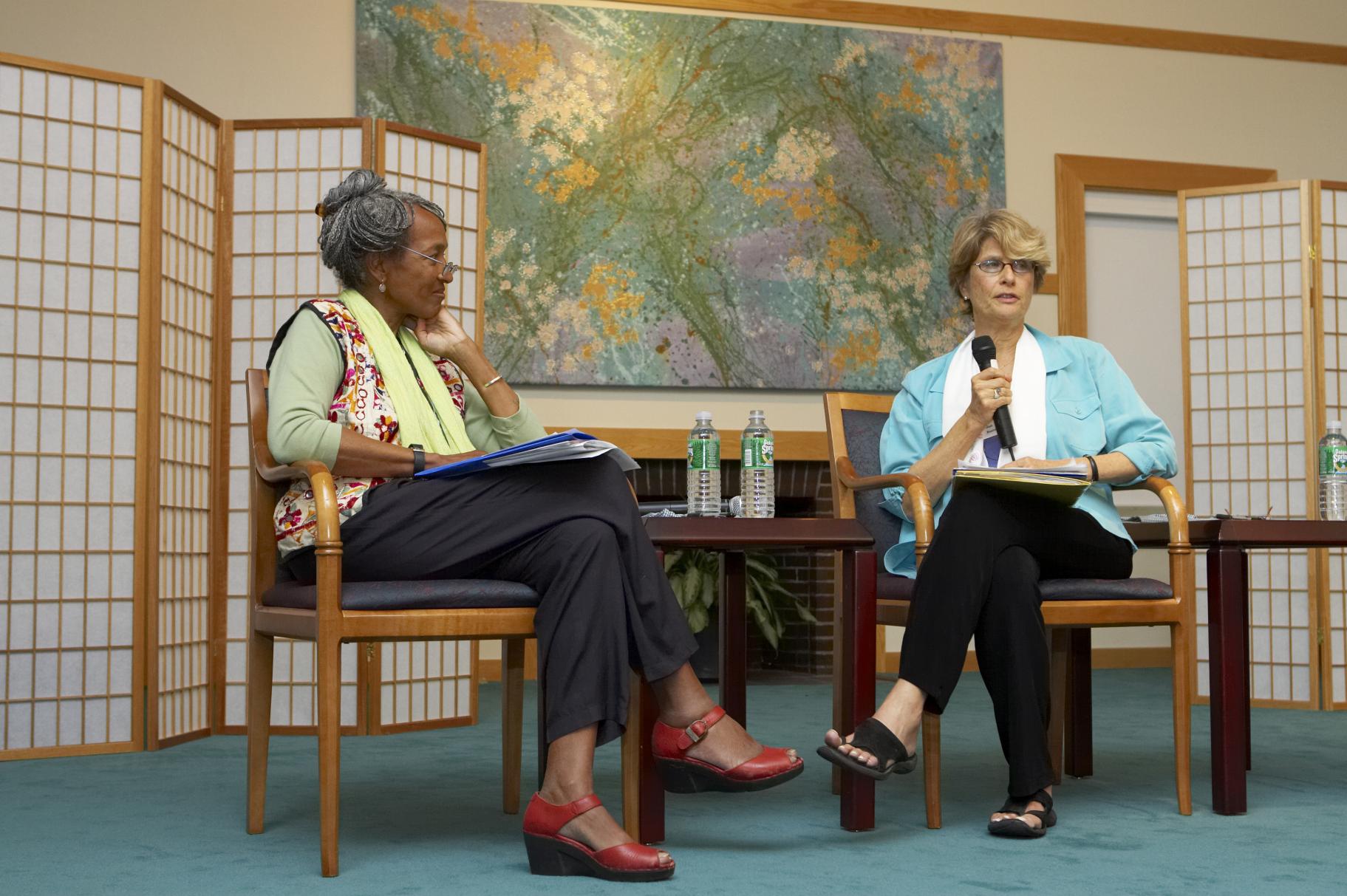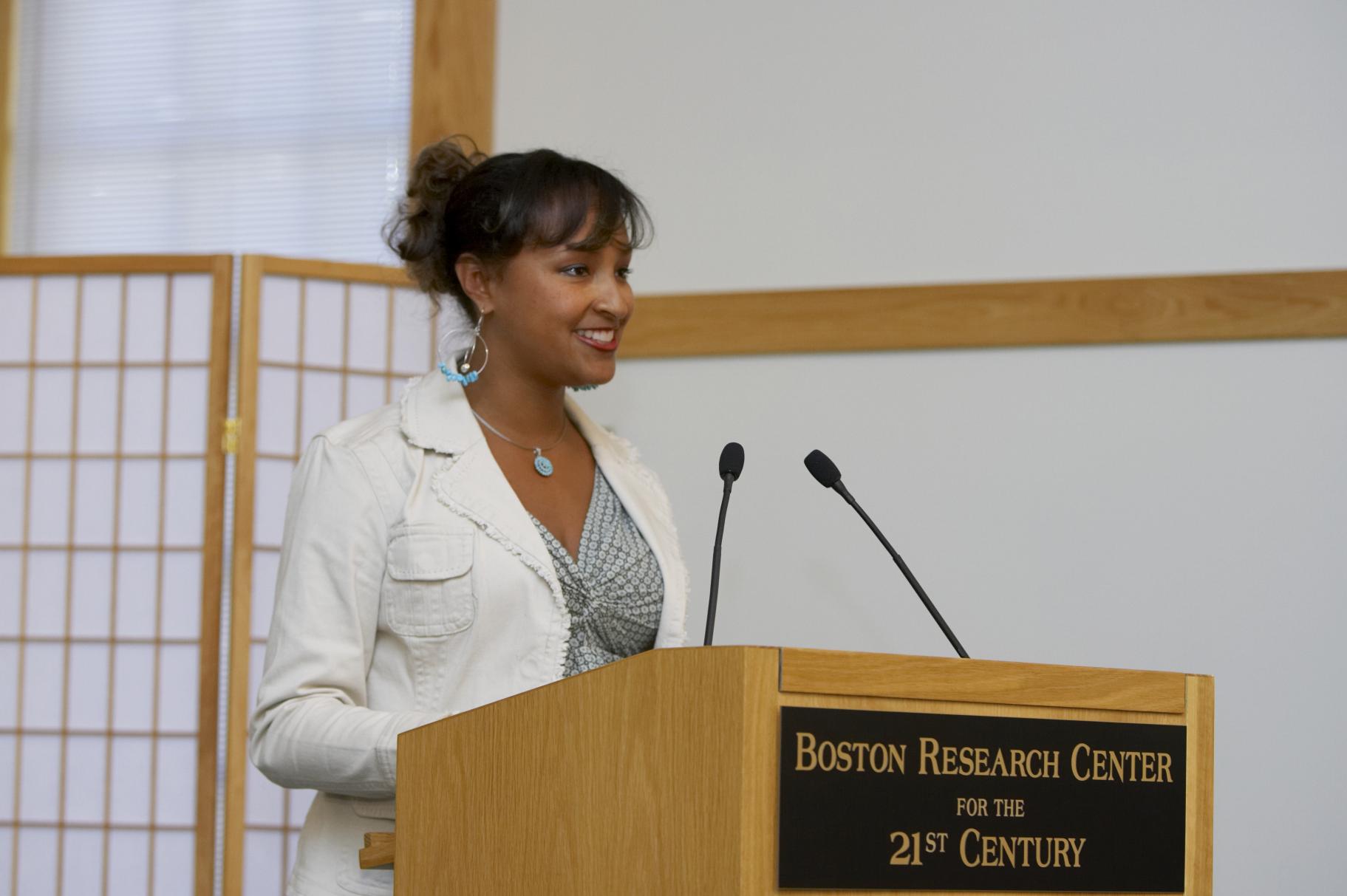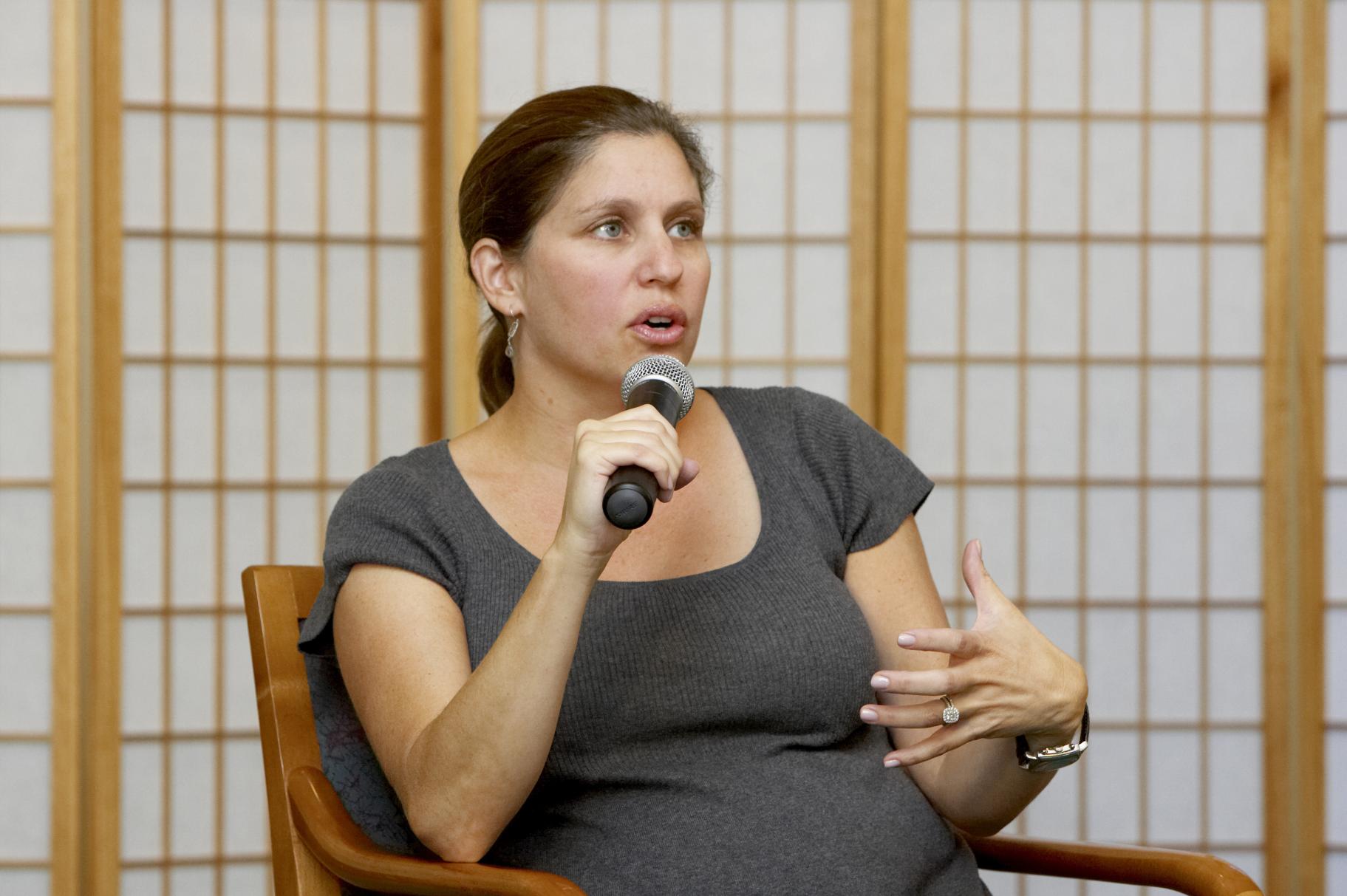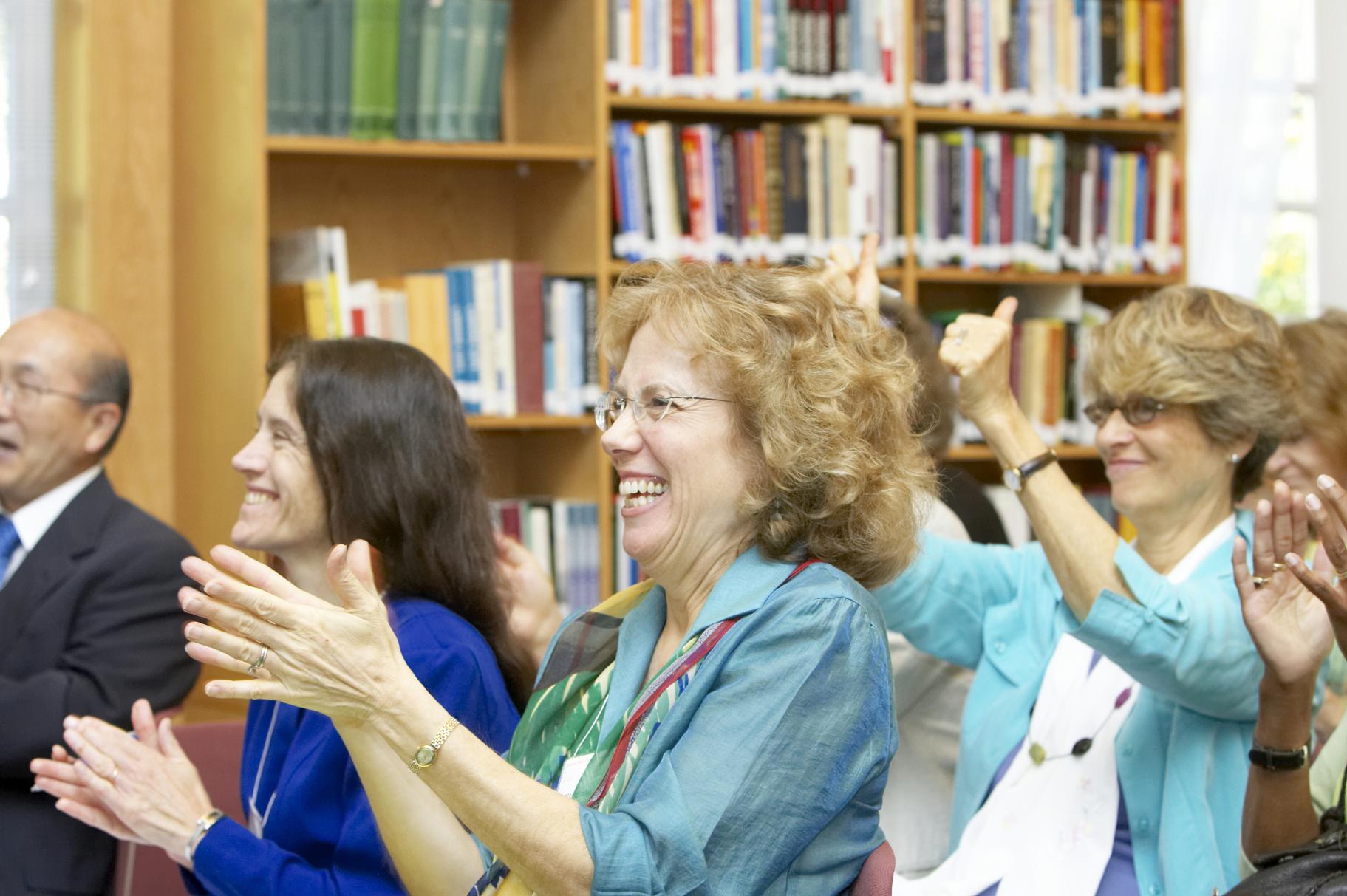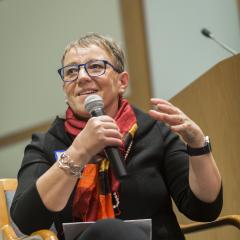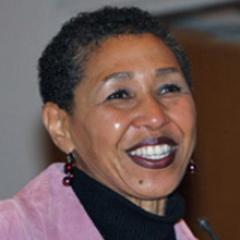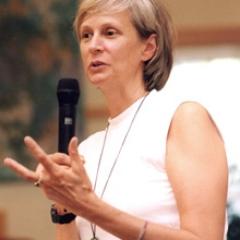2007 Ikeda Forum: Women and the Power of Friendship
Charlene Haddock Seigfried, Joycelyn Moody, and Anita Patterson explore the topic of women, friendship, and diversity in 19th century America
The Fourth Ikeda Forum for Intercultural Dialogue took place at the Center’s meeting space on Sept. 29, 2007. During his welcome, Center President Masao Yokota said that when the Buddha was asked about the importance of friendship, he replied that friendship is everything. Yokota said that the founder of the Center, Daisaku Ikeda, also has an unconditional regard for friendship and a fundamental trust in people.
To illustrate, Yokota recalled how, in 1960, when Ikeda visited the US for the first time, he and his entourage knew nothing about the country and even less English; they were completely dependent on their friends who lived in the States. When they arrived at Honolulu airport, no one was there to meet them. Everyone in the party, except Ikeda, was very upset, complaining: “Where are our friends? Where did they go?” Ikeda showed a different attitude, said Yokota; he was concerned that there had been a misunderstanding or, worse, an accident. Instead of complaining, he worried about his friends, demonstrating his unconditional trust in others.
Unfortunately, continued Yokota, if we have unconditional trust in others, it is easy to be betrayed. Still, Ikeda insists: “I’d rather be betrayed than betray others.” Yokota added that Ikeda especially trusts women, even declaring the 21st century to be the century of women. Yokota concluded with the reflection that Ikeda counts on women to show how to heal the wounds of separation.
Next, Executive Director Virginia Benson welcomed the audience, many of whom were first-time visitors to the Center, and gave a brief summary of its history and mission. Turning to the theme of the Forum, Benson shared a quotation from Daisaku Ikeda:
The Earth gives people life; nations take it from them. The Earth nourishes life; nations throw it away. If nations are the products of men squabbling for territory and influence, then the Earth is the realm of mothers. This realm of mothers, who love life, is far greater and grander than the nation-states created by men. The twenty-first century will be the century of life. It will be the century of women. We must make it an age where the prayers for peace of all mothers since the beginning of history are finally answered (SGI Newsletter, Aug-Sept, 1998, p. 106).
Benson then explained that in Ikeda’s view, a view shared by her and the Center, the power of friendship is crucial for transforming differences, creating collective wisdom, and discovering mutual beliefs. One need only look at our global challenges, said Benson, to understand the relevance of this insight. With the leaders of the U.S. getting better and better at creating serious enemies worldwide by emphasizing cultural and religious divisions, said Benson, the power of friendship to bridge differences of all kinds is of the utmost importance.
Turning to the day’s program, Benson said that the purpose of the forum would be to explore the dynamics of friendship and social change as experienced by women, past and present. The morning speakers would be looking at 19th century America; examining how American women first emerged as a force for social change and how their friendships served to empower them, with special consideration to issues of race, class, and diversity. The afternoon would feature contemporary women activists reflecting on the role of friendship in their efforts to promote social change.
The Power of Poetry: A Conversation with Andrew Gebert and Sarah Wider
Andrew Gebert, a translator of Ikeda’s poetry, spoke next, sharing a short example of the poetry Ikeda has written to encourage women and mothers. “Even if you are considered an ordinary woman/in your gentleness and beauty/that should not bother you/for you, yourself know/that ideals and courage lie within.”
This poem, Gebert explained, is one in a group of poems — all written for women — in which Ikeda reaches across the most fundamental barrier: that of self and other. Gebert said that Ikeda writes from the relational sense of the word “I,” speaking for another using the “I” voice. It can be quite powerful and encouraging, said Gebert, to receive these poems written in the first person. He shared another poem to illustrate: “For my own sake/I will bloom strongly, beautifully/therefore, I strive to elevate/and enhance the scale of my being.” By speaking in the first person, concluded Gebert, Ikeda conveys the sense that he is right there beside the reader, in relation to her, sharing her struggle to grow.
Sarah Wider, Professor of English and Women’s Studies, Colgate University, responded to these poems, recounting that after her mother’s death she found solace in Ikeda’s poetry. She appreciated the empathic voice of “a poet who will kindly enter that space with us, not as an intrusion but as an act of love that enables us not to be alone in the hardest of times.”
Wider said she was particularly struck by a poem he wrote to the women of Soka Gakkai entitled ” The 21st century is the Century of Women”. In it, he talks about women who work for a particular kind of social justice. These are ordinary women, not the leaders of the political world but the leaders of everyday life. In the excerpt she discussed, Wider said that Mr. Ikeda celebrates the ordinary wife, woman, mother whose strength and wisdom surpasses that of her husband and children because it derives from her own experience and struggle. “She lives within the friendship of those who have gone before her and from that friendship draws strength and wisdom for her next action,” said Wider.
In a crucial scene, which Wider recited, Ikeda portrays a household in which the mother is looked down on by spouse and children alike, all based on the status of each as a “scholar,” “student,” or “genius,” as well as their ability to best the mother in an argument. They assume her inferiority and they claim their superiority, and yet she refuses to be silenced by their arrogance, which she knows to be superficial. Finally, Ikeda encourages the mother in the poem with the words of Goethe: “Trust in life! / It teaches us more / than any orator or book can!” The mother gains strength from these words. Wider then asked the audience to consider the extent to which this dynamic plays out in our own daily lives. How do we treat our mothers, aunts, sisters, co-workers, daughters? Wider concluded that it is not clear if the family in the poem would continue to disrespect the mother. Whatever their choice, Wider was confident that the mother would nonetheless continue to embody the wisdom she knows from her experience.
Anita Patterson: “We Are Yet Made Friends and Sisters”
The three morning speakers were slated to explore the topic of women, friendship, and diversity in 19th century America. First up was Anita Patterson, Associate Professor of English at Boston University. She set the stage for the speakers to follow by quoting from Henry David Thoreau: “Friends cherish each other’s hopes. They are kind to each other’s dreams.”
Next, she posed the two key questions of this year’s Ikeda Forum: How has friendship, especially among women, contributed to the work of reform? And to what extent has friendship helped foster emerging coalitions among women activists and reformers to break through boundaries of race, class, and culture? Patterson then introduced her own thesis: “Friends, then as now, faced institutional as well as psychological barriers; loyalties were divided by realities of power and the damaging effects of racial hierarchy. Nevertheless, if we can acknowledge these limitations and constraints, we can strengthen our efforts towards reform.”
Patterson introduced her historical reflections by observing that women have long played an important role in the process of social reform in the United States, but it is only recently that they have been “rescued from the margins of historical narrative and scholarly debate.” Turning her attention to specific aspects of 19th century history, Patterson noted that women reformers were typically engaged in multiple causes ranging from abolitionism to educational reform to suffrage. Most of these activities were undertaken by white middle class women, who worked primarily in the domestic as opposed to the political arena. Gathering into voluntary associations, the women pioneered and developed new modes of social activism; for example, holding anti-slavery fairs, gathering in sewing circles for fugitive slaves, and even organizing boycotts. These voluntary associations bridged the public world of politics and the private world of family and home. The friendship and intimacy of these women strengthened the abolitionist movement, while at the same time the women themselves drew closer fighting in common cause. “We are yet made friends and sisters,” wrote one in a letter.
However, said Patterson, this sense of solidarity within the women’s anti-slavery movement was not easily extended to the African American women who might have been partners in the cause. For example, many of the middle class white women of the movement discouraged participation by women they didn’t consider to be ‘ladies’ a term, noted Patterson, loaded with race- and class-based overtones. In one instance, three black women applied for membership in the Anti-Slavery Society of Fall River, and were initially barred from membership. “Racism was a clear, unavoidable problem,” said Patterson, “and cross-racial friendships and collaborations, when and if they did occur, were marked by tension, limitation, and ambiguity.” Such tensions were also at play in the women’s suffrage movement, where, in the post-Civil War era, activists debated which was more important, “Negro suffrage” or “woman suffrage.”
Patterson concluded that though the legacy of women’s reform and friendship in the 19th century is mixed, it is nevertheless important to look at the exceptions to the rule and efforts made at cross-racial friendship. Furthermore, women should be applauded for their achievements, given the social and political context. Patterson also urged participants to reflect on how our own institutions and social practices affect our friendships and cross-cultural relationships. Friendship remains crucial, she concluded; its expansive qualities “nourish and sustain the spirit of reform.”
Joycelyn Moody: Women’s Writing Relationships across Race in Antebellum US
The historical stage so eloquently set by Professor Patterson provided a backdrop for Joycelyn Moody’s presentation. Moody, Professor of American Literature at the University of Texas at San Antonio, explained that in her talk she would be discussing the nature of interracial female friendship in 19th century America, including an exploration of whether terms other than friendship might better characterize the positive relationships that developed at that time.
Seeking an encouraging example, Moody researched the relationship between the slave Harriet Jacobs and the author, abolitionist, and journalist Lydia Marie Child, who was instrumental in the publication of Jacobs’ seminal autobiography Incidents in the Life of a Slave Girl (1861), for which she also wrote the introduction. According to Moody, her research showed that this important achievement was not so much the result of a friendship between the two women; rather “it was the product of a positive, powerful working relationship that benefited each woman.” Given the realities of slavery in the US in 1860, said Moody, friendship between a white woman and a black woman was probably not possible, “even given the great compassion of each woman.”
Moody then provided some background, explaining that, based both on her research and her experience, she considers compassion and equality to be two important prerequisites for friendship. She also quoted Susan Koppleman’s definition that “intrinsic to all friendships is mutual reflection for the friends of images of themselves they cherish, visions of their best selves.” Professor Moody argued that in the 19th century, and even now, friendship so defined would be difficult for most white women to accept: “It seems to me,” said Moody, “that the return image of a black woman’s face as the mutual reflection of her own has blocked many a white woman from genuine friendship with a black woman, so great is and has been Negrophobia since the first traders invaded Africa.”
As a fugitive slave and a white abolitionist, Jacobs and Childs were separated by barriers of race and class, which translated into unequal access to power, a clear impediment to friendship. Nevertheless, Child utilized her access in the service of telling an important story, said Moody, adding: “One significant lesson that their interracial alliance offers us today is that mentoring across race can work, can sometimes include intimacy, and is always essential to progressive social activism.” She said the reason their collaboration succeeded was due to Child’s own insight into prejudice and her extraordinary commitment to ending slavery and racial oppression.
Moody clarified that though she doesn’t refer to the women as friends, they had a mutual respect for each other and shared important beliefs. Indeed, said Moody, Jacobs found Child to be a “whole-souled Woman.” And Child writes of Jacobs in her introduction: “The author of the following autobiography is personally known to me, and her conversation and manners inspire me with confidence,” adding that Jacobs was “highly esteemed” by those who knew her. This positive relationship is not to be taken for granted, said Moody. For example, the mutual respect required for a mentoring relationship was absent in other well-known collaborations, including the publication of the speeches of Sojourner Truth. In that case, said Moody, the white women who admired Truth and promoted her work, including women as prominent as Harriet Beecher Stowe, tended to maintain “an objectifying and condescending distance” from the subject of their efforts.
Before concluding, Moody explored the obstacles to interracial female friendship that arose because of the sexual abuses of slave owners, who routinely molested slave women, thus setting up a range of tensions between slave owners’ wives and the women slaves. One result, said Moody, was the development of the stereotype of women slaves as amoral and promiscuous while the Southern white female was considered chaste, passive, and dependent. Professor Moody emphasized that this legacy continues to serve as an impediment for genuine interracial friendship. She stressed that it is important for women to have a frank dialogue about sex in order to engage in a meaningful dialogue about friendship.
“In the meantime,” she concluded, “we do well to trace the cross-cultural collaborations, and to strive to imitate Jacobs and Child as women who recognized that their respect for each other could help each meet her individual goal to enrich the public good.
Charlene Haddock Seigfried: Working Among the People: Intercultural Friendships and the Settlement House Movement
Charlene Haddock Seigfried, Professor of Philosophy and American Studies at Purdue University, elaborated on the work of Jane Addams, the founder of Hull House, an influential model for social and community reform in America. She opened by observing that it was because of Jane Addams’ unique qualities — her intellect, patience, practical experience, genuine compassion, and her insistence on treating all people as equals—that she was able to develop a genuinely democratic community at Hull House. Because of these same qualities, said Seigfried, Addams was able to build friendships that extended beyond the limits of class, race, ethnicity, and gender.
Hull House was founded in 1889 by Addams and her friend Ellen Gates Starr, and the spirit of friendship widespread among women reformers of the late 19th and early 20th century helped shape Hull House’s character. Seigfried said that “Addams later recalled with obvious pleasure the … years when ‘cooperation among women was new and the companionship exhilarating’.” Hull House attracted female reformers and activists, known as “residents,” who worked for social changes and improvement in the local community and in Chicago as a whole. Among these residents were women such as Julia Lathrop, Alice Hamilton, and Florence Kelly. But the Hull House community extended well beyond the close-knit community of female reformers, creating a circle that included Chicago’s academic pragmatists John Dewey and George Hebert Meade, and the renowned African American leaders Ida B. Wells and W.E.B. DuBois.
Critically, said Seigfried, the circle of relationships at Hull House included not only these “luminaries,” but also “the many people of diverse nationalities in the Chicago tenement houses whom she sought out and who poured through the Hull House doors.” Addams, explained Seigfried, “insisted on calling them ‘neighbors,’ rather than clients or charity recipients,” pointing to the essence of Addams’ contribution. “This practice of patiently coming to know the needs of the immigrant, inner-city neighborhood around the Hull House settlement is extremely important,” said Seigfried, “because it marks a deliberate break with the top-down model of giving to the poor or displaced or despised ethnic groups what those who thought themselves superior thought they needed, rather than letting their neighbors express their needs and working with them to bring about long-term solutions.”
Addams, continued Seigfried, saw the multitudes of people living side by side in the “squalid industrial districts of Chicago” as a model for peace among nations after the devastation of Word War I. She did not consider the ideal of common humanity as a mere abstraction, added Seigfried. Rather, her hope was that “sustained only by daily knowledge and companionship,” people would participate in “a complex struggle forward, each race and nation contributing its quota; that the variety and continuity of this co-mingled life afford its charm and value.” Seigfried then went on to explore some of the methods that Addams employed in achieving her dream of diverse people and groups working together for social progress. Along with the aforementioned absence of condescension, these included, said Seigfried: a stance of “sympathetic neutrality and cooperative listening” that sought to “reconcile … various points of view into a workable approach”; and a willingness both to not be blinded by “purity of intent” and to see that “no one has a monopoly on truth or goodness.”
Reflecting on the work and legacy of Jane Addams, Seigfried identified some lessons for us today: “If we do not recognize that race, class, sex, and levels of education can both intimidate those differently positioned and blind those better off to their own biases,” she said, “we will fail to grasp significant features of situations and not understand why our well-intentioned suggestions can trigger angry reactions. Conscious steps need to be taken to work through prejudices on all sides, and Addams proposes that working with all the diverse persons affected by our actions is the best way.”
The Power of Friendship in the 21st Century
Fast-forwarding to the 21st century in the afternoon session, Sarah Wider began by raising more questions about the nature of friendship, art, and creativity and how they work together. She introduced a poem, “Good Woman” by Heid Erdrich, which would also be used later in the day’s closing activity.
She also introduced a section of a poem by Daisaku Ikeda, written to Natalie Satz, the founder of Russia’s first children’s theater. Observed Wider: “Ikeda places art in the center of a healthy society and he focuses on the kind of power we experience through the creation of art.” Then she recited:
Art is the power to live
Like the pulse of spring
reviving nature.
The irrepressible energy
of life itself, transcending
suffering and pain,
to arrive finally at joy.Art is the power to love
A symphony of fraternity
that continually discovers
the brilliant jewel
existing in the heart
of each and all.Art is the power
of mutual belief.
A multi-hued bridge
linking all people
founded solidly
on the universally human
beyond differences personal
and national.
Discussing each of the three powers of art referred to in the poem, Wider emphasized the power of mutual belief: “It is the most incredible power, and we wonder if it is still open to us,” she said. The subsequent presentations by four good women indicated that indeed it is.
A Few Good Women: Betty Burkes and Jan Surrey
The first afternoon presenters were two Boston-area activists, Betty Burkes, co-chair of Cambridge Peace Commission, and Jan Surrey, clinical psychologist, who reflected on the profound impact their friendship has had on their lives and work. The two met several years ago during a BRC Learning Circle on community building. Burkes recalled that when she heard Jan speak in the Circle about her vulnerability and her self-doubt in love and work, it touched her own memories of suffering from isolation. Burkes was especially moved by Jan’s frankness about the pain of living in relational disconnection and her willingness to bear witness to her strength and struggle. “[Jan’s] refusal to accept separation … touched my own unrequited desire for the same courage and faith. Her journey resonated with my own history of struggle for love, affirmation, for belonging.” Burkes added that Jan’s clarity and commitment to healing and relational wholeness reinforced her own hope for the possibility of restorative connections. “In the moment of her speaking and my listening, a transcendent moment was kindled. … I was captured by the possibility of an unconditional friendship between us.”
Surrey concurred that in that moment she felt profoundly seen and heard by Betty, adding that her transformative experience with the Learning Circle has convinced her that it should be the basis for her work in the 21st century. Surrey then shared her experience in the Circle of listening intently to Betty, who told of her deep bond with her grandmother. Since then, said Surrey, the two have continued to meet, transcending what she called the “you and I” model of relationship in the process.
Shaped by their shared experience, the two friends have introduced the concept of relational activism into their respective work. Relational activism, explained Surrey and Burkes, is a source of vitality providing opportunity for growth and enhanced connections. Both have come to realize that non-relational models of activism are outmoded and ineffectual. In their telling, relational activism is a dynamic creative process of mutuality, inclusion, observation, and deep listening. Through their dialogues, said Surrey and Burkes, they have discovered that relational activism is present when relationships are grounded in respect, empathy, and connection; and when relationships come first and incorporate actions that lead toward greater connections with self and others.
Burkes observed: “Through relational activism, I have come to understand the elements of organizing for change that build connection and unity, without negating the centrality of oppression and inequality that has wounded and continues to harm both human and non-human communities.”
The session concluded with the audience engaging in dialogue with the panelists, addressing such questions as: How can our relationships contribute to the 21st century? How can we do justice to our relationships so we can do justice in the world?
Scherazade King
The next speaker, Scherazade King, opened by sharing that when she was teaching in Ghana several years ago, she was inspired by the level of social engagement she witnessed in that culture — more, she said, than she had ever experienced in this country. King recalled that she returned to the US determined to somehow contribute to a culture of engagement. Discouraged by the negative effect media and popular culture had on American youth, she decided to tackle the media on its own terms. She founded a nonprofit called Project: Think Different, a media and arts organization that uses popular culture media to increase the power of voices in civic dialogue.
King talked about how her project has been motivated by her belief that music, film, and video are dynamic means to give voice to the disempowered and enable more people to be agents of positive social change. Then, King shared how the ideas presented by the previous speakers had inspired her to consider her work from a fresh perspective. For example, she was now able to see more clearly the role of friendship and collaboration in developing her “Dream Team” of artists and activists. She added that the day’s insightful presentations had even inspired her to “reframe” her idea of friendship itself, wondering. “Can I imagine that my friendships can be a resource for my own change and for larger social change — the kind of social change that my work and others’ work is creating? Maybe not in the way I had originally hoped and planned, but nonetheless, yes.”
Ms. King’s reflections about the role of friendship in her work provoked thoughtful questions and comments from the audience. One young man observed that in order for the 19th-century women to take on social reform, to courageously step outside of their traditional roles, they must have come together with a shared vision and commitment to make a difference, which is the message he heard in King’s talk. He then asked King whether there was a spiritual dimension that keeps her forging ahead during challenges.
King replied that she is always striving to make the connection between spirituality and activism. “I really do believe that in order for activism to be sustainable, it has to be rooted in spirit in a way that is life-giving and healthy. … I feel, based on my lifetime and the anger I have carried around with me for a long time, that anger is not a sustainable way of perpetuating activism. There needs to be a way that you can heal and take action from a place that’s grounded in wholeness and that kind of spirit.” She added that “there are a variety of places that people can go to be fed spiritually,” specifically mentioning an organization called Spirit in Action, which looks at the connection between spirituality and activism.
King continued with the theme, noting that Project: Think Different examines the devastating impact that media has had on our spirits. The messages from the media, and television in particular, she said, have contributed to our sense of disenfranchisement and a decrease in civic engagement. Ultimately, said King, her work is about producing music, video, and film projects that will inspire people, feed the spirit, and “interrupt” the messages that people are receiving from the mainstream media.
Ms. King’s talk was met with appreciation from the audience, who had seen some of her media spots on television, and with an acknowledgement from activist Betty Burkes, who thanked her “for being on the front lines of the 21 st century, a place that many of us have stepped back from.”
Susan Retik
The final speaker was Susan Retik, who told the tragic but hopeful story of how she came to found an international nonprofit organization. On the beautiful New England morning of September 11, 2001, said Retik, the dream that she and her husband David had been living suddenly became a nightmare. Though they had a beautiful home in the suburbs with two children and another one on the way, everything changed when the plane David boarded for a Los Angeles business trip was hijacked and flown into the World Trade Center.
Retik recalled that the outpouring of support from family, neighbors, the government, and even strangers was overwhelming. But when the US invaded Afghanistan, her perspective and her life were to be changed yet again. While watching a program on Afghan women, Retik learned that the majority of them are illiterate, innumerate, and forbidden under Taliban law to work or go to school. Then, she said, a simple question occurred to her: If life was so dreadful for Afghan women, she wondered, how much worse must it be for widows?
It was in grappling with that question, Retik told the audience, that she conceived of her organization, called BeyondThe11th.org. Retik was joined in founding Beyond the 11th by Patti Quigley, another pregnant widow of 9/11 whom she had befriended. Together they researched the living conditions of Afghani widows. And what they learned, said Retik, was far worse than they had imagined. For example, in contrast to the outpouring of help the Americans received, an Afghan widow has no insurance and has to relinquish her dead husband’s property to his family. Since she cannot go out without a male in public, Retik added, she often has to send her children to beg for food. “The disparity between the level of help we received compared to our counterparts in Afghanistan was startling,” she said.
Beyond the 11th was officially formed in the fall of 2003, with the mission to help widows affected by war and terrorism in Afghanistan. They have raised most of their money through a fundraising event called Cycling Forward, which centers on bicycle rides between Ground Zero and Boston.
In May of 2006, the two women flew to Kabul to visit the NGOs to whom they had given grants. They also visited many of the widows they wished to help. “We laughed, we cried with these women, we shared food and shared stories,” Retik said. “Prior to 9/11, I couldn’t have told you where Afghanistan is. As Americans, we have the luxury to walk around with blinders on. I was able to do that until 9/11 forced me to realize that we are all connected. It is so easy to forget about the problems of the rest of the world—that is, until we realize that their problems are our problems.” When Retik finished, many in the audiences wiped away tears, moved by the extraordinary efforts and achievements of two friends joined by tragedy.
Conclusion
For the day’s concluding session, led by Sarah Wider and Anita Patterson, participants engaged in a poetry exercise using the poem “Good Woman,” which Wider had introduced earlier that afternoon. Working together in groups, they created a new version of the poem, reflecting their experiences of the day. Finally, Betty Burkes taught everyone a simple closing song:
From you I receive
To you I give
Together we share and
from this we live
Photos by Marilyn Humphries
